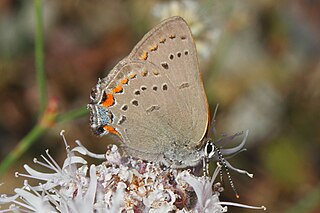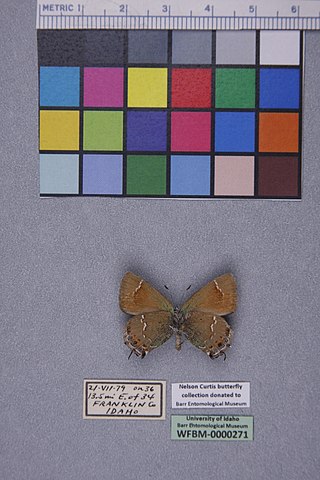
Lycaenidae is the second-largest family of butterflies, with over 6,000 species worldwide, whose members are also called gossamer-winged butterflies. They constitute about 30% of the known butterfly species.

The great purple hairstreak, also called the great blue hairstreak, is a common gossamer-winged butterfly species in parts of the United States. It is actually a Neotropical species; its North American range only includes the warm-temperate and subtropical parts of that continent, and it ranges southwards almost to the Isthmus of Panama. The type specimen, however, was shipped to Europe from the Colony of Virginia, probably around the time of the United States Declaration of Independence.

The green hairstreak is a small butterfly in the family Lycaenidae.

Smith's blue butterfly, Euphilotes enoptes smithi, is a subspecies of butterfly in the family Lycaenidae. This federally listed endangered subspecies of Euphilotes enoptes occurs in fragmented populations along the Central Coast of California, primarily associated with sand dune habitat in one case with a dune-based Maritime Coast Range Ponderosa Pine forest in the Carbonera Creek watershed in Santa Cruz County. The range of E. e. smithi is from Monterey Bay south to Punta Gorda.

The genus Callophrys consists of butterflies in the family Lycaenidae. It is apparently not monophyletic, but which of the taxa currently considered junior synonyms of Callophrys are valid genera remains to be determined.

The Sandia hairstreak is a species of butterfly native to North America. A relatively rare butterfly with a limited range, it was discovered in La Cueva Canyon, Albuquerque, in spring of 1958, by Noel McFarland, then a student at the University of Kansas, and described the following year. The Sandia hairstreak was made one of the state insects of New Mexico in a 2002 bill approved the following year.

Callophrys gryneus, the juniper hairstreak or olive hairstreak, is a butterfly native to North America. It belongs in the family Lycaenidae.

Chlorostrymon simaethis, the silver-banded hairstreak, is a North and South American butterfly in the family Lycaenidae. It is also known as St. Christopher's hairstreak and the Key lime hairstreak.

Callophrys dumetorum, te bramble hairstreak or lotus hairstreak, is a butterfly of the family Lycaenidae. It is found in the United States in coastal California and rarely in inland California. Subspecies C. d. oregonensis is known as the Oregon green hairstreak.

Callophrys sheridanii, the Sheridan's hairstreak and Sheridan's green hairstreak, is a butterfly in the family Lycaenidae. It is found in North America along the south coast of British Columbia and parts of Nevada, Arizona, Saskatchewan, North Dakota, and New Mexico. In 2009, this species was adopted as the U.S. state butterfly for Wyoming.

Callophrys augustinus, the brown elfin, is a species of butterfly of the family Lycaenidae, found from Alaska to northern Mexico. One of its subspecies, C. augustinus iroides, is known as the western elfin.

Satyrium californica, the California hairstreak, is a butterfly of the family Lycaenidae. It is found from British Columbia south to southern California and east to Colorado.

Callophrys spinetorum, the thicket hairstreak, is a butterfly of the family Lycaenidae. It was described by William Chapman Hewitson in 1867. It is found in North America from British Columbia through the Rocky Mountains to New Mexico and Mexico and through California to Baja California. The habitat consists of pinyon-juniper forests, mixed woodlands, and coniferous forests.

Callophrys affinis, the western green hairstreak or immaculate green hairstreak, is a butterfly of the family Lycaenidae. It is found in western Canada and the western United States.

Mitoura rosneri, the Rosner's hairstreak, is a butterfly of the family Lycaenidae. It is found in western North America in British Columbia. and Washington state. Subspecies C. r. plicataria is known as Barry's hairstreak.

Callophrys xami, commonly referred to as the xami hairstreak or green hairstreak, is a butterfly included in the subgenus Xamia and the genus Callophrys in the family Lycaenidae. It was described by Tryon Reakirt in 1867. Other common names for this species, depending on the region, include green hairstreak and elfin. C. xami is considered to be a very rare species of butterfly, and its typical range is in southern Arizona and Texas including down south to Guatemala. The juniper hairstreak and the silver-banded hairstreak butterflies are similar species, but both differ significantly from C. xami in regards to the postmedian white line running across the butterfly wings.
Callophrys hesseli, or Hessel's hairstreak, is a butterfly of the family Lycaenidae. It ranges from southern Maine south along the Atlantic coastal plain to northern Florida on the Gulf Coast. The species was first described by George W. Rawson and J. Benjamin Ziegler in 1950, in honor of the lepidopterist Sidney Adolphus Hessel. It is listed as endangered in Connecticut by state authorities.

Callophrys nelsoni, or Nelson's hairstreak, is a species of butterfly belonging to the genus Callophrys, wingspan of approximately 1 to 1.5 inches. Like many members of the Lycaenidae family, this butterfly has distinctive rod-like antennae. Callophrys nelsoni are gernually found throughout the west coast of the United States. Although they can be found along the very bottom of Canada's British Columbia and down to Baja California Norte.

Eriogonum elongatum, commonly known as longstem buckwheat or wand buckwheat, is a species of wild buckwheat native to coastal southern and Baja California.

















